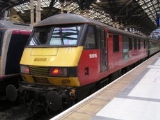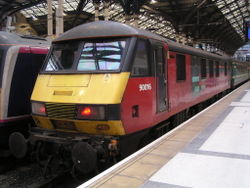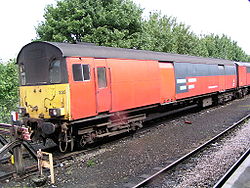Upon the sectorisation of
British RailBritish Railways , which from 1965 traded as British Rail, was the operator of most of the rail transport in Great Britain between 1948 and 1997. It was formed from the nationalisation of the "Big Four" British railway companies and lasted until the gradual privatisation of British Rail, in stages...
during the 1980s the
Parcels Sector was created. In 1991 this was rebranded
Rail Express Systems. The Rail Express Systems launch event was held at Crewe Diesel Depot in October 1991. For this event examples of Class 08, 47, 86 & 90 locomotives were painted into a new livery of red, with a grey upper band, and light blue and grey flashes. The light blue and grey flashes represent a set of stylised eagles wings.
This sector of British Rail was responsible for transport of mail and parcels traffic, including the Travelling Post Office trains, as well as taking over the charter operations from
IntercityInterCity was introduced by British Rail in 1966 as a brand-name for its long-haul express passenger services ....
.
The sector had maintenance depots at Crewe Diesel, Bristol Barton Hill, Cambridge & Euston Downside. Rolling stock was also maintained by other sectors at Heaton depot in Newcastle and Liverpool Edge Hill.
During the existence of the Parcels sector there were many changes in the use of rail to deliver mail and parcels. Smaller services were cut back, and in many cases in saw the end of mail services using passenger stations. These changes were in part through the Railnet scheme initiated in 1996 which created mail hubs at Shieldmuir (Motherwell), Low Fell (Newcastle), Warrington, Doncaster, Bristol Parkway, Tonbridge, and Wembley PRDC (London) as well as dedicated platforms at Stafford.
The company was bought by EWS in 1996.
Mid 1990s Routes
Travelling Post Office Routes
- London-Glasgow
- London-Carlisle
- London-Newcastle
- London-Dover
- London-Norwich
- Penzance-Bristol
- Plymouth-Newcastle
- Cardiff-Glasgow
|
|
Other Mail Trains
- London-Bristol
- London-Glasgow
- London-Newcastle
- London-Norwich
- London-Plymouth
- London-Swansea
- Plymouth-Glasgow
- Plymouth-Newcastle
|
Parcels Sector Rolling Stock
The late 1980s and early 1990s saw many changes to the Rail Express Systems fleet, with the cessation of the usage of Class 105s by 1987, Class 114s by 1990, Class 120s by 1987, Class 127s by 1989, Class 302s by 1996 and Class 308s by 1989.
In the same period Class 325 EMUs were introduced and the entire parcels and mails fleet with the exception of the Travelling Post Office stock was refurbished or withdrawn.
Locomotives
- Class 08
The British Rail Class 08 is a class of diesel-electric shunting locomotive. From 1953 to 1962, 996 locomotives were produced, making it the most numerous of all British locomotive classes....
- Class 31
The British Rail Class 31 diesel locomotives, also known as the Brush Type 2 and originally as Class 30, were built by Brush Traction from 1957-62.- Description :...
- Class 47
The British Rail Class 47, is a class of British railway diesel-electric locomotive that was developed in the 1960s by Brush Traction. A total of 512 Class 47s were built at Crewe Works and Brush's Falcon Works, Loughborough between 1962 and 1968, which made them the most numerous class of British...
- Class 86
The British Rail Class 86 was the standard electric locomotive built during the 1960s, developed as a result of testing with the earlier Classes 81, 82, 83, 84 and 85. One hundred of these locomotives were built from 1965-1966 by either English Electric at Vulcan Foundry, Newton-le-Willows, or...
- Class 90
The British Rail Class 90 electric locomotives were built by BREL at Crewe from 1987-1990. Each locomotive weighs 84.5 tonnes and has a top speed of . They operate from 25 kV AC overhead wires and produce...
Multiple Units
- Class 105
The British Rail Class 105 diesel multiple units were built by Cravens Ltd. of Sheffield from 1956 to 1959. The class were built with a side profile identical to British Railways Mark 1 carriage stock, using the same doors and windows. None were selected for refurbishment...
- Class 114/1
The British Rail Class 114 diesel multiple units were built by BR Derby from 1956 to 1957. Forty-nine 2-car units were built, numbered 50001-49 for driving motors and 56001-49 for driving trailers . The units were used in the early days out of Lincoln TMD on services all over the county...
- Class 120
The Class 120, were a cross-country DMU in three-car formation, built at the British Rail Swindon Works.Totalling 194 cars, three batches were built:*1958 - 49 sets for the Western Region*1959 - 7 sets for the Scottish Region...
- Class 127
The British Rail Class 127 diesel multiple units were built by BR Derby in 1959. Thirty 4-car units were built, formed of two outer driving motor vehicles, sandwiching two intermediate trailers which were classified class 186...
- Class 302/9
The British Rail Class 302 was a type of electric multiple unit introduced between 1958 - 1960 for outer suburban passenger services on the London, Tilbury and Southend Railway route...
- Class 308/9
The British Rail Class 308 alternating current electric multiple units were built by BR at York, in three batches, from 1959–61. They were initially classified as AM8 units before the introduction of TOPS.-Class 308/1:...
- Class 325
The British Rail Class 325 is a 4 car dual-voltage 25 kV alternating current or 750 V direct current electric multiple unit train used for postal train services. They are based on the Class 319. The Class 325 was British Rail's newest unit to take over parcels working on electrified...
|
|
Coaching Stock
- NAA - Propelling Control Vehicle
A Propelling Control Vehicle is a type of British railway carriage for carrying mail. They were converted from Class 307 driving trailers and have a cab at one end. This allows mail trains to be propelled at low speed, with the locomotive at the rear of the train being driven from the...
- NBA - Brake Guard (High-security)
- NDX - Brake Guard (90 mph)
- NEX - Brake Guard (100 mph)
- NHA - Brake Guard (110 mph)
- NIA - Brake Guard (High-security) (110 mph)
- NJX - General Utility Van
A General Utility Van is a type of rail vehicle built by British Rail and its predecessors, which was primarily used for transporting mail and parcels. They were used by both Express Parcels Systems, the British Post Office and Railtrack. National Rail and some Train Operating Companies still use...
(90 mph)
- NKA - General Utility Van (High-security) (100 mph)
|
|
Coaching Stock (cont.)
- NLX - Newspaper Van
A General Utility Van is a type of rail vehicle built by British Rail and its predecessors, which was primarily used for transporting mail and parcels. They were used by both Express Parcels Systems, the British Post Office and Railtrack. National Rail and some Train Operating Companies still use...
- NNX - Courier Vehicle
- NPX - General Utility Van (TPO use)
- NOA - General Utility Van (100 mph)
- NRA - Container Van
A General Utility Van is a type of rail vehicle built by British Rail and its predecessors, which was primarily used for transporting mail and parcels. They were used by both Express Parcels Systems, the British Post Office and Railtrack. National Rail and some Train Operating Companies still use...
- NSA - Post Office Sorting Van
A Post Office Sorting Van is a type of rail vehicle built for use in a Travelling Post Office.British Rail built ninety-six of these vehicles between 1959 and 1977, to several similar designs, all based on the Mark 1 coach design. They were numbered in the range 80300–80395...
- NTA - Post Office Stowage Van
A Post Office Stowage Van is a type of rail vehicle built for use in a Travelling Post Office . Several of these have passed into preservation as they are very useful for storage on the railways.-Preservation:...
- NUA - Brake Post Office Stowage Van
A Brake Post Office Stowage Van is a type of rail vehicle built for use in a Travelling Post Office.British Rail built nine of these vehicles between 1959 and 1968, to two similar designs, both based on the Mark 1 coach design. They were numbered in the range 80450-80458...
|
The source of this article is
wikipedia, the free encyclopedia. The text of this article is licensed under the
GFDL.




